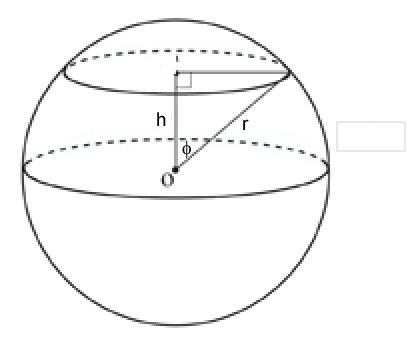a) Show that the formula for the surface area of a sphere with radius #r# is #4pir^2#. b) If a portion of the sphere is removed to form a spherical cap of height #h# then then show the curved surface area is #2pihr^2#?
a) Show that the formula for the surface area of a sphere with radius #r# is #4pir^2# .
b) If a portion of the sphere is removed to form a spherical cap of height #h# then then show the curved surface area is #2pihr^2#
a) Show that the formula for the surface area of a sphere with radius
b) If a portion of the sphere is removed to form a spherical cap of height
2 Answers
A = int dA
Explanation:
An area element on a sphere has constant radius r, and two angles. One is longitude
So the area element is
Integrated over the whole sphere gives
In part b,
Then
Note: Every derivation I found of this result uses cylindrical coordinates and is far more involved than this one. Can someone else check?
a)
b)
Explanation:
It is easier to use Spherical Coordinates, rather than Cylindrical or rectangular coordinates. This solution looks long because I have broken down every step, but it can be computer in just a few lines of calculation
With spherical coordinates, we can define a sphere of radius
The Jacobian for Spherical Coordinates is given by
And so we can calculate the surface area of a sphere of radius
# A = int int_R \ \ dS \ \ \ #
where
# :. A = int_0^pi \ int_0^(2pi) \ r^2 sin phi \ d theta \ d phi#
If we look at the inner integral we have:
# int_0^(2pi) \ r^2 sin phi \ d theta = r^2sin phi \ int_0^(2pi) \ d theta #
# " " = r^2sin phi [ \ theta \ ]_0^(2pi)#
# " " = (r^2sin phi) (2pi-0)#
# " " = 2pir^2 sin phi#
So our integral becomes:
# A = int_0^pi \ 2pir^2 sin phi \ d phi#
# \ \ \ = -2pir^2 { cos phi ]_0^pi#
# \ \ \ = -2pir^2 (cospi-cos0)#
# \ \ \ = -2pir^2 (-1-1)#
# \ \ \ = -2pir^2 (-2)#
# \ \ \ = 4pir^2 \ \ \ # QED
For the area of the portion of a sphere we have a similar set-up:
By trigonometry
# A = int_arccos(h/r)^(pi/2) \ int_0^(2pi) \ r^2 sin phi \ d theta \ d phi#
# \ \ \ = int_arccos(h/r)^(pi/2) \ (r^2sin phi)(2pi-0) \ d phi#
# \ \ \ = int_arccos(h/r)^(pi/2) \ 2pir^2sin phi \ d phi#
# \ \ \ = -2pir^2[cosphi]_arccos(h/r)^(pi/2) #
# \ \ \ = -2pir^2(cos(pi/2)-cos(arccos(h/r))) #
# \ \ \ = -2pir^2(0-h/r) #
# \ \ \ = -2pir^2(-h/r) #
# \ \ \ = 2pihr^2 \ \ \ # QED



